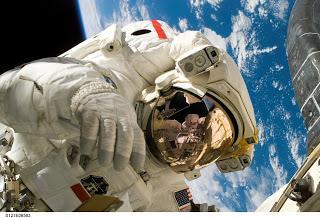
5 NASA Inventions That Are Now Everyday Household Items
Ever since I first watched Star Trek as a child, I’ve always been interested in space-age technology. Ideas such as faster-than-light travel or realistic virtual realities still fascinate me – even though I understand little of the science behind them!
In comparison to sci-fi technology, it’s sometimes easy to forget how astonishing “everyday” items actually are. Society has developed so rapidly over the last 100-150 years that we quickly become indifferent to technological breakthroughs – even when they come as a direct result of space research. With that in mind, here are five everyday items that were first developed by NASA.

1. Scratch-Proof Glasses
As you can imagine, it’s important for an astronaut’s visor not to get scratched. That’s why NASA scientists in the 1970s put a lot of time into developing strong plastics coated with a thin film to prevent scratching. The result was visors that were up to ten times less likely to scratch than previous versions.
Fast forward a decade, and sunglass manufacturer Foster-Grant realised the same technology could be used on their products. The company was the first to license it from NASA, although today most plastic lenses have a similar coating.

2. Memory Foam Mattresses
Walk into any mattress shop and you’ll almost certainly be greeted be a sales person extolling the virtues of memory foam. This type of foam, which contours to your body to provide extra support while sleeping, has become popular in recent years.
What many people don’t know is that memory foam was first developed by NASA as a way to protect passengers during a crash. It’s still used for that today, but is also found in pillows, mattresses and even roller coasters due to its ability to absorb energy.

3. Water Filters
One of the challenges of long-term space missions, such as establishing a base on the Moon, is producing clean water. That’s why NASA has been collaborating with a number of companies to develop water filtration systems. The first filters were designed in the 1970s and could handle basic cleaning. In recent years, new filters are being created to convert water with greater contamination – including human urine – into a drinkable form.
While this technology might not be found in the average western home, it has the potential to make a big difference in poorer countries where clean water is scarce.

4. Handheld Cordless Vacuums
An example of a more mundane NASA technology is the humble handheld vacuum. Before the Apollo mission, NASA commissioned Black & Decker to produce a drill to collect samples from the moon. This needed a highly optimised motor and tiny power consumption, as energy would be at a premium during the mission.
Later on, the same technology would be used to create the Dustbuster range of vacuums. Black & Decker still produce Dustbusters today, although handheld vacuums are now built by a wide range of companies.

5. Cochlear Implants
In the 1970s, analog hearing aids simply magnified sound. This meant any noise or imperfections would also be amplified.
At the time, NASA was putting a lot of research time into sound and electronic sensing. An engineer named Adam Kissiah, who also had hearing difficulties, realised this technology could be used to produce an implant that would transmit sound digitally.
He founded a private company to develop a working prototype of the cochlear implant. Since then, hundreds of thousands of people have had their hearing restored – including people who have been deaf since birth.
 James Hall is a home technology writer from the UK. Aside from writing, he enjoys hiking, cycling and spending time with his family. He's always had an interest in space-age technology and has high hopes for the next-generation of virtual reality devices. He's currently writing for Spotless Vacuum and you can also find him on Twitter.
James Hall is a home technology writer from the UK. Aside from writing, he enjoys hiking, cycling and spending time with his family. He's always had an interest in space-age technology and has high hopes for the next-generation of virtual reality devices. He's currently writing for Spotless Vacuum and you can also find him on Twitter.
